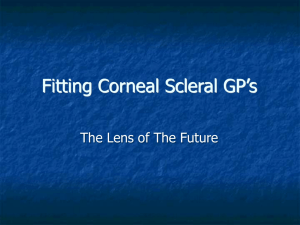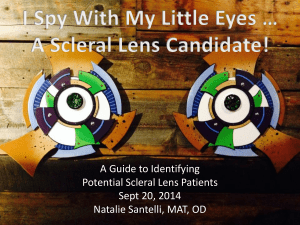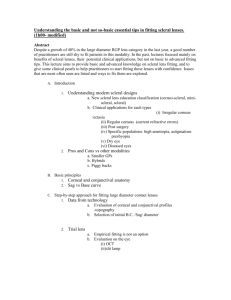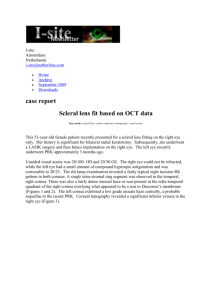here
advertisement
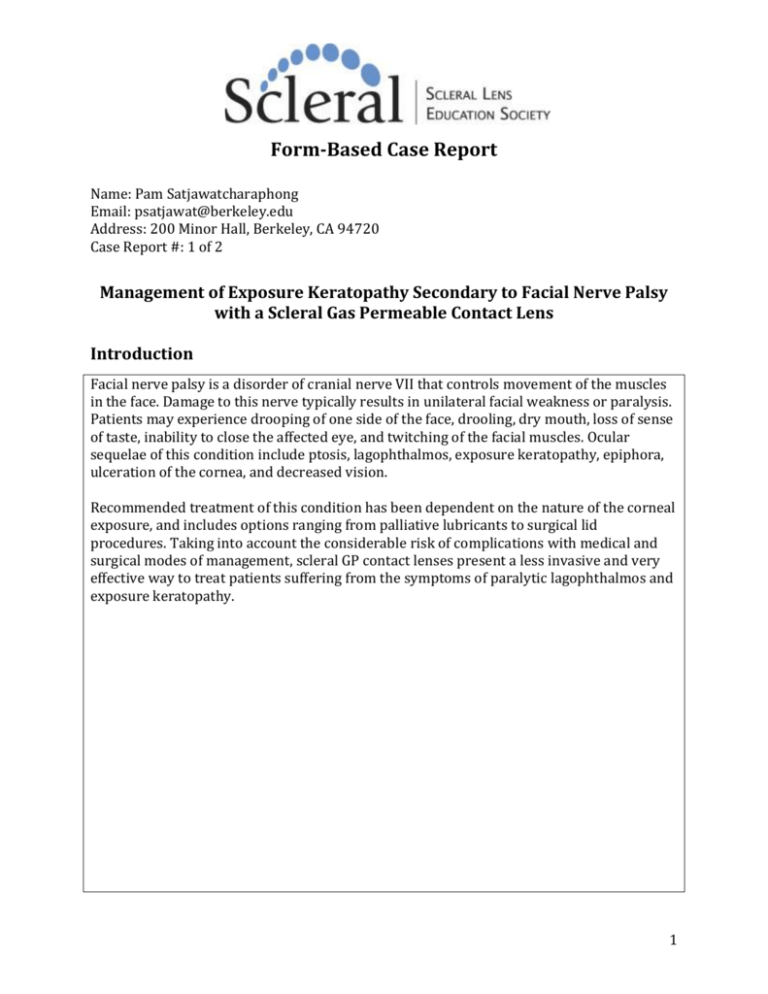
Form-Based Case Report Name: Pam Satjawatcharaphong Email: psatjawat@berkeley.edu Address: 200 Minor Hall, Berkeley, CA 94720 Case Report #: 1 of 2 Management of Exposure Keratopathy Secondary to Facial Nerve Palsy with a Scleral Gas Permeable Contact Lens Introduction Facial nerve palsy is a disorder of cranial nerve VII that controls movement of the muscles in the face. Damage to this nerve typically results in unilateral facial weakness or paralysis. Patients may experience drooping of one side of the face, drooling, dry mouth, loss of sense of taste, inability to close the affected eye, and twitching of the facial muscles. Ocular sequelae of this condition include ptosis, lagophthalmos, exposure keratopathy, epiphora, ulceration of the cornea, and decreased vision. Recommended treatment of this condition has been dependent on the nature of the corneal exposure, and includes options ranging from palliative lubricants to surgical lid procedures. Taking into account the considerable risk of complications with medical and surgical modes of management, scleral GP contact lenses present a less invasive and very effective way to treat patients suffering from the symptoms of paralytic lagophthalmos and exposure keratopathy. 1 Case Report Patient Demographics & History Patient initials: JC Patient age, race, and gender: 50 year old Caucasian female Occupation: Unemployed Personal ocular history: Acoustic neuroma surgery at age 25 resulting in cranial nerve VII damage and permanent right facial paralysis. Gold weights were subsequently implanted in the upper lid. Personal medical history: Acid reflux disease Current medications: Protonix Drug allergies: None Family ocular history: Unremarkable Family medical history: Arthritis, cancer Other notes: N/A Examination Findings Visit # 1 of 6 Date of Examination 8/1/2012 Referral? Yes No Chief Complaint/Purpose of Visit: Constant severe dryness OD Entering vision: Uncorrected Glasses OD -3.75-0.50x008 (VA 20/200) OS -4.75-1.00x145 (VA 20/15) Contact Lenses Other Refraction: OD -3.75-0.50x008 (VA 20/200) OS -4.75-1.00x145 (VA 20/15) Pupils: PERRL (-)APD Extraocular Muscles: Full OU 2 Anterior Segment OD Ptosis due to gold weight implant, lagophthalmos, Gr 2+ plugged glands Gr 2 hyperemia Unremarkable Gr 1 engorged vessels Gr 4+ staining and keratinization inferiorly (Figure 1), Gr 1+ arcus Deep and quiet Flat, blue Gr 1+ nuclear sclerosis Lids/Lashes OS Gr 1+ plugged glands Bulbar Conjunctiva Palpebral Conjunctiva Sclera Cornea Unremarkable Unremarkable Gr 1 engorged vessels Gr 1+ arcus Anterior Chamber Iris Lens Deep and quiet Flat, blue Gr 1+ nuclear sclerosis Figure 1 – Severe staining with sodium fluorescein and Wrattan filter Intraocular Pressure: Goldmann Tonopen OD 18 mmHg OS 17 mmHg at 4:07 PM Visual Field: OD Full OS Full Dilation drops? Yes NCT Other Type: Confrontation VF No 3 Posterior Segment OD Distinct margins, choroidal crescent 0.30H/0.30V Present Flat, even, avascular Unremarkable Normal caliber Unremarkable Unremarkable Optic Nerve C/D Foveal Reflex Macula Posterior Pole Vasculature Periphery Vitreous OS Distinct margins, choroidal crescent 0.50H/0.50V Present Flat, even, avascular Unremarkable Normal caliber Unremarkable Unremarkable Additional Testing Figure 2 - Medmont Corneal Topography Showing Irregular Astigmatism OD and Regular With-the-rule Astigmatism OS 4 Assessment: 1. Exposure keratopathy OD 2. Irregular astigmatism secondary to corneal keratinization OD (Figure 2) 3. Glaucoma suspect based on asymmetric C/D Plan: 1-2. Return in 1 week to initiate scleral lens fitting OD to improve both ocular comfort and vision 3. Refer for glaucoma work-up Contact Lens Fitting Visit # 2 of 6 Date of Examination 8/8/2012 Chief Complaint/Purpose of Visit: Scleral lens fitting Entering Vision: Uncorrected Glasses OD -3.75-0.50x008 (VA 20/200) OS -4.75-1.00x145 (VA 20/15) Contact Lenses Other Anterior Segment Notes: OD No change from visit 1 OS No change from visit 1 Trial Lens Design: Jupiter Standard Scleral Length of time trial lens settled before fit assessment: 30 minutes OD Trial # 1 of 1 41.00 (8.23) Base Curve N/A Sagittal Depth 18.2/8.2 Diameter/OZ -1.50 Power Standard Peripheral Curves Modified: 300 um apical clearance, Fit Description full limbal clearance, trace edge lift at the 3 o’clock and 9 o’clock lens margins, and no blood vessel blanching -7.50 Over-Refraction 20/40 VA OS N/A N/A N/A N/A N/A N/A N/A N/A 5 Ordered Lens Design: Jupiter Standard Scleral OD Lens Order 41.00 (8.23) Base Curve N/A Sagittal Depth 18.2/8.2 Diameter/OZ -4.75 Power Standard Peripheral Curves Modified:Steepen PC4 Boston XO Material OS N/A N/A N/A N/A N/A N/A Assessment: Ordered first scleral lens OD. Since the patient wanted to continue to wear her current spectacles over the contact lens to protect her eyes, the contact lens power that was ordered was adjusted to compensate for her spectacle lens power. The fourth peripheral curve was steepened slightly due to the edge lift noted with the trial lens. Plan: Return in 2 weeks for scleral lens dispense and training. 6 Visit # 3 of 6 Date of Examination 8/24/12 Chief Complaint/Purpose of Visit: Scleral lens first dispense and training Entering Vision: Uncorrected Glasses OD -3.75-0.50x008 (VA 20/200) OS -4.75-1.00x145 (VA 20/15) Contact Lenses Lens Design: Jupiter Standard Scleral OD 41.00 (8.23) Base Curve N/A Sagittal Depth 18.2/8.2 Diameter/OZ -4.75 Power Standard Peripheral Curves Modified:Steepen PC4 Boston XO Material 300 um apical clearance, Fit Description full limbal clearance (Figure 3) with no vessel blanching and good scleral alignment (Figures 4a-4d) 20/40+2 VA +0.25 (20/30) Over-Refraction (VA) Anterior Segment Notes: OD No change from visit 2 OS No change from visit 2 Other OS N/A N/A N/A N/A N/A N/A N/A N/A N/A Application and Removal Successful? Yes No Dispense Lenses? Yes Solution Recommended for Cleaning/Disinfection/Storage: Boston Simplus Solution Recommended for Filling Lens: Unisol 4 Additional Instructions to Patient: N/A New Lens Order? Yes No Lens Design: N/A OD N/A N/A N/A N/A N/A N/A Lens Order Base Curve. Sagittal Depth Diameter/OZ Power Peripheral Curves Material No OS N/A N/A N/A N/A N/A N/A 7 Figure 3 – Scleral lens filled with sodium fluorescein showing corneal and limbal clearance Figures 4a-4d—Proper alignment of the contact lens with the sclera in all quadrants Assessment: Good initial comfort, fit, and vision with scleral OD. Plan: Dispensed scleral to patient. The patient was instructed on proper cleaning regimen and to allow for an adaptation period when first wearing this lens—starting with 6 hours gradually increasing wear time until full-time wear was achieved. The patient was also told not to sleep in the lens, so in order to continue to provide corneal protection, JC used a lubricating ointment for her right eye before bedtime. Return for 2 week follow-up appointment. 8 Visit # 4 of 6 Date of Examination 9/7/2012 Chief Complaint/Purpose of Visit: 2 week scleral lens follow-up. Patient reports significant subjective improvement in dryness symptoms and vision OD. Entering Vision: Uncorrected Glasses Contact Lenses OD Scleral with overlay glasses (VA 20/20-) OS Glasses (VA 20/15) Other Average Comfortable Wearing Time: 12 hours Wearing Time On Day of Visit: 4 hours Lens Design: Jupiter Standard Scleral OD OS 41.00 (8.23) Base Curve N/A N/A Sagittal Depth N/A 18.2/8.2 Diameter/OZ N/A -4.75 Power N/A Standard Peripheral Curves N/A Modified:Steepen PC4 Boston XO Material N/A 200 um apical clearance, Fit Description N/A full limbal clearance, no vessel blanching and good scleral alignment, some mucus strands on surface 20/20VA N/A +0.25 (No improvement) Over-Refraction (VA) N/A Anterior Segment Notes: OD Improvement in corneal staining from Gr 4+ to Gr 3. Also improvement in ptosis as scleral acts as crutch for upper lid (Figure 5a-b). Otherwise, no changes from visit 3. OS No change from visit 3 Dispense Lenses? Yes No N/A Additional Instructions to Patient: N/A New Lens Order? Yes No Lens Design: N/A OD N/A N/A N/A N/A N/A N/A Lens Order Base Curve. Sagittal Depth Diameter/OZ Power Peripheral Curves Material OS N/A N/A N/A N/A N/A N/A 9 Figure 5a - Eye without scleral (left) Figure 5b – eye with scleral showing improvement in ptosis (right) Assessment: Improved vision and comfort with scleral lens OD. Plan: Continue with current OD lens, and discussed with patient that improvement in vision likely due to improved corneal staining. Patient can use rewetting drops over scleral or remove lens to clean as needed. Patient should continue to use ointment at night. Return in 2 months for progress check. 10 Visit # 5 of 6 Date of Examination 11/9/2012 Chief Complaint/Purpose of Visit: 2 month scleral lens progress check. Patient reports continued good comfort and vision. Entering Vision: Uncorrected Glasses Contact Lenses OD Scleral with overlay glasses (VA 20/20-) OS Glasses (VA 20/15) Other Average Comfortable Wearing Time: 12 hours Wearing Time On Day of Visit: 6 hours Lens Design: Jupiter Standard Scleral OD OS 41.00 (8.23) Base Curve N/A N/A Sagittal Depth N/A 18.2/8.2 Diameter/OZ N/A -4.75 Power N/A Standard Peripheral Curves N/A Modified:Steepen PC4 Boston XO Material N/A 200 um apical clearance, Fit Description N/A full limbal clearance, good scleral alignment except some mild blanching over shallow temporal pinguecula 20/20VA N/A Plano (No improvement) Over-Refraction (VA) N/A O Anterior Segment Notes: OD Improvement in corneal staining from Gr 3 to Gr 2 (Figure 6), otherwise no change from visit 4 OS No change from visit 4 Dispense Lenses? Yes No N/A Additional Instructions to Patient: N/A New Lens Order? Yes No Lens Design: N/A OD N/A N/A N/A N/A N/A N/A Lens Order Base Curve. Sagittal Depth Diameter/OZ Power Peripheral Curves Material OS N/A N/A N/A N/A N/A N/A 11 Figure 6 –Moderate staining with sodium fluorescein over the inferior cornea Assessment: Continued good vision and comfort with scleral lens OD. The fit remained acceptable since the blanching over the pinguecula was focal and very mild; it did not cause any bulbar hyperemia or other adverse effects so no lens parameter changes were needed. Plan: Continue habitual routine with the scleral lens OD. Return in 6 months for progress check. 12 Visit # 6 of 6 Date of Examination 5/3/2015 Chief Complaint/Purpose of Visit: 6 month scleral lens progress check. Patient reports continued good comfort and vision. Entering Vision: Uncorrected Glasses Contact Lenses OD Scleral with overlay glasses (VA 20/20-2) OS Glasses (VA 20/15) Other Average Comfortable Wearing Time: 12 hours Wearing Time On Day of Visit: 3 hours Lens Design: Jupiter Standard Scleral OD OS 41.00 (8.23) Base Curve N/A N/A Sagittal Depth N/A 18.2/8.2 Diameter/OZ N/A -4.75 Power N/A Standard Peripheral Curves N/A Modified:Steepen PC4 Boston XO Material N/A 200 um apical clearance, Fit Description N/A full limbal clearance, good scleral alignment except some mild blanching over shallow temporal pinguecula 20/20-2 VA N/A Plano (No improvement) Over-Refraction (VA) N/A Anterior Segment Notes: OD Improvement in corneal staining from Gr 2 to Gr 1 (Figure 7), otherwise no change from visit 5 OS No change from visit 5 O Dispense Lenses? Yes No N/A Additional Instructions to Patient: N/A New Lens Order? Yes No Lens Design: N/A OD N/A N/A N/A N/A N/A N/A Lens Order Base Curve. Sagittal Depth Diameter/OZ Power Peripheral Curves Material OS N/A N/A N/A N/A N/A N/A 13 Figure 7 –Mild staining with sodium fluorescein over the inferior cornea near the limbus Assessment: Continued good vision, comfort and fit with scleral lens OD. Plan: Continue habitual routine with the scleral lens OD. Return in 6 months for annual contact lens examination. 14 Discussion Final Diagnosis: Facial nerve palsy resulting in exposure keratopathy and irregular corneal astigmatism Description of ocular disease: Facial nerve palsy is a disorder of cranial nerve VII that controls movement of the muscles in the face. Damage to this nerve typically causes unilateral facial weakness or paralysis, though in about 10% of cases the paralysis is bilateral. Symptoms experienced by the unilateral palsy patient include drooping of one side of the face, drooling, dry mouth, loss of sense of taste, inability to close the affected eye, and twitching of the facial muscles. Ocular sequelae of this condition include ptosis, lagophthalmos, exposure keratopathy, epiphora, ulceration of the cornea, and decreased vision. This condition can result from a number of different etiologies including surgery for an acoustic neuroma or parotid tumor, but when it is idiopathic it is termed a Bell’s Palsy. Upon ocular examination afflicted individuals will exhibit a number of signs, including punctate epithelial erosions of the inferior portion of the cornea, epithelial breakdown, stromal melting which may lead to perforation, secondary ocular infection, and scarring. Describe alternative treatment options: Recommended treatment of this condition has been dependent on the nature of the corneal exposure, and includes a wide range of options. Conservative management has included palliative treatment with non-preserved artificial tears throughout the day with a lubricating ointment at night, taping the eyelid shut, or bandage contact lenses. Medical management that can temporarily improve eyelid closure has been documented with the use of botulinum toxin injection of the levator palpebrae muscle. Permanent corneal exposure has been managed with surgical methods, including tarsorrhaphy, palpebral spring implants, or gold weights inserted in the upper eyelid. Of the aforementioned methods, gold eyelid weighting continues to be the most widely used method of management despite a high rate of complications, including poor cosmesis from visibility of the weight under the skin, migration, extrusion, allergy, and astigmatism. Describe final treatment option: Scleral GP contact lenses present a less invasive and very effective way to treat patients suffering from the symptoms exposure keratopathy by providing a protective barrier for the entire cornea. It can also improve vision if the cornea has resultant irregularity from scarring. Was the patient’s chief complaint resolved? Yes No Was the patient fit successfully for at least 3 months? Yes No If answer to either of the previous two questions is “No”, please explain why: N/A 15 Conclusion Facial Nerve Palsy often results in severe dry eye and pain from exposure keratopathy. Keratinization and corneal insult leading to irregular astigmatism can also decrease vision of the affected eye. Scleral GP contact lenses present a viable alternative treatment option to manage both ocular dry eye symptoms and decreased visual acuity that result from these conditions, but patients should be followed regularly to ensure that corneal physiological health is maintained. It would be beneficial to perform a study collecting data regarding any complications that may result from wearing scleral GP lenses over long periods of time in order to have a more complete understanding of scleral GP lens wear, and thus enable practitioners to prescribe them with confidence. 16 References 1. Tasman, W, Jaeger, EA. Duane's Ophthalmology, 9th Edition, Philadelphia: Lippincott Williams & Wilkins, 2009. 2. Kanski, JK. Clinical Ophthalmology: A Systematic Approach, 6th Edition, Philadelphia: Elsevier, 2007. 3. Rahman I, Sadiq SA. Ophthalmic management of facial nerve palsy: a review. Survey of Ophthalmology. 2007; 52(2):121-44. 4. Prell J, Rampp S, Rachinger J, Scheller C, Alfieri A, Marguardt L, Strauss C, Bau V. Botulinum toxin for temporary corneal protection after surgery for vestibular schwannoma. J Neurosurg. 2011; 114(2)426-31. 5. Bulstrode NW, Harrison DH. The phenomenon of the late recovered Bell’s palsy: treatment options to improve facial symmetry. Plast Recostr Surg. 2005; 115(6):146671 6. Manodh P, Devadoss P, Kumar N. Gold weight implantation as a treatment measure for correction of paralytic lagophthalmos. Indian J Dent Res. 2011; 22(1):181. 7. Lessa S, Nanci M, Sebastia R, Flores E. Treatment of paralytic lagophthalmos with gold weight implants covered by levator aponeurosis. Ophthal Plast Reconstr Surg. 2009; 25(3):189-93. 8. Muller-Jensen K, Jansen M. 6 years experience with reversible and surgical upper eyelid weighting in lagophthalmos. Ophthalmologe. 1997; 94(4):295-9. 9. Silver AL, Lindsay RW, Cheney ML, Hadlock TA. Thin-profile platinum eyelid weighting: a superior option in the paralyzed eye. Plast Reconstr Surg. 2009; 123(6):1697-703. 10. Bladen JC, Norris, JH, Malhotra R. Indications and outcomes or revision of gold weight implants in upper eyelid loading. Br J Ophthalmol. 2011 Oct 27. 11. Mandell R. Contact Lens Practice, 4th Edition. Charles C. Thomas, Springfield IL, 1988. 12. Van der Worp E. A Guide to Scleral Lens Fitting. Pacific University College of Optometry, 2010 13. Severinsky B, Millodot M. Current applications and efficacy of scleral contact lenses—a retrospective study. Journal of Optometry. 2010; 3(3):158-63. 14. Pullum, K, Buckley R. Therapeutic and ocular surface indications for scleral contact lenses. The Ocular Surface. 2007; 5(1):40-9. 15. Ehler Justis P, Shah Chirag P. The Wills Eye Manual: Office and Emergency Room Diagnosis and Treatment of Eye Disease. Baltimore: Lippincott, Williams and Wilkins; 2008. 17
